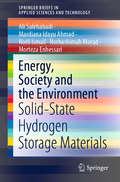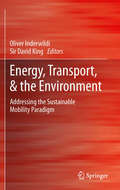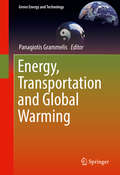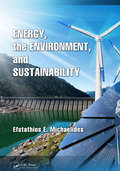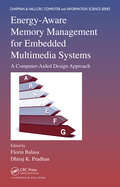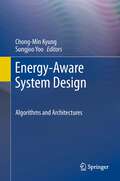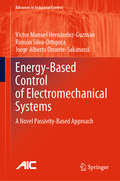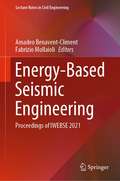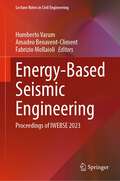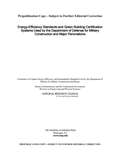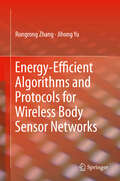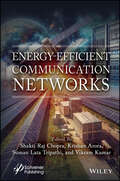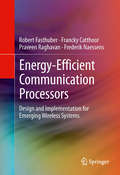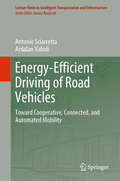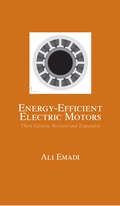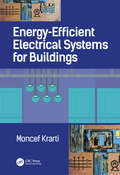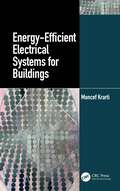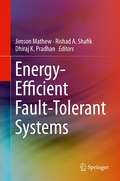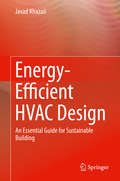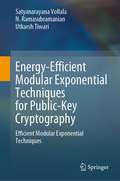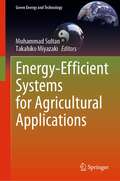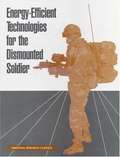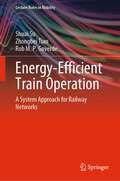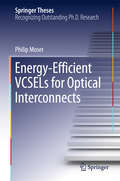- Table View
- List View
Energy, Society and the Environment: Solid-State Hydrogen Storage Materials (SpringerBriefs in Applied Sciences and Technology)
by Mardiana Idayu Ahmad Ali Salehabadi Norli Ismail Norhashimah Morad Morteza EnhessariThis book provides a comprehensive and contemporary overview of advances in energy and energy storage technologies. Although the coverage is varied and diverse, the book also addresses unifying patterns and trends in order to enrich readers’ understanding of energy and energy storage systems, particularly hydrogen energy storage, including e.g. their morphology, porosity and material structure. Readers will also gain insights into the hydrogen storage performance landscape, based on data released by the US Department of Energy (DOE), providing a basis for understanding real-world applications. The book also discusses the superior hydrogen storage performance of solid-state materials and explores the physical and chemical properties that can potentially affect their performance.
Energy, Transport, & the Environment
by Oliver Inderwildi Sir David KingSustainable mobility is a highly complex problem as it is affected by the interactions between socio-economic, environmental, technological and political issues. Energy, Transport, & the Environment: Addressing the Sustainable Mobility Paradigm brings together leading figures from business, academia and governments to address the challenges and opportunities involved in working towards sustainable mobility. Key thinkers and decision makers approach topics and debates including: energy security and resource scarcity greenhouse gas and pollutant emissions urban planning, transport systems and their management governance and finance of transformation ·the threats of terrorism and climate change to our transport systems. Introduced by a preface from U.S. Secretary of Energy, Steven Chu and an outline by the editors, Dr Oliver Inderwildi and Sir David King, Energy, Transport, & the Environment is divided into six sections. These sections address and explore the challenges and opportunities for energy supply, road transport, urban mobility, aviation, sea and rail, as well as finance and economics in transport. Possible solutions, ranging from alternative fuels to advanced urban planning and policy levers, will be examined in order to deepen the understanding of currently proposed solutions within the political realities of the dominating economic areas. The result of this detailed investigation is an integrated view of sustainable transport for both people and freight, making Energy, Transport, & the Environment key reading for researchers, decision makers and policy experts across the public and private sectors.
Energy, Transport, & the Environment: Addressing the Sustainable Mobility Paradigm
by Oliver Inderwildi Sir David KingSustainable mobility is a highly complex problem as it is affected by the interactions between socio-economic, environmental, technological and political issues. Energy, Transport, & the Environment: Addressing the Sustainable Mobility Paradigm brings together leading figures from business, academia and governments to address the challenges and opportunities involved in working towards sustainable mobility. Key thinkers and decision makers approach topics and debates including: energy security and resource scarcity greenhouse gas and pollutant emissions urban planning, transport systems and their management governance and finance of transformation·the threats of terrorism and climate change to our transport systems. Introduced by a preface from U.S. Secretary of Energy, Steven Chu and an outline by the editors, Dr Oliver Inderwildi and Sir David King, Energy, Transport, & the Environment is divided into six sections. These sections address and explore the challenges and opportunities for energy supply, road transport, urban mobility, aviation, sea and rail, as well as finance and economics in transport. Possible solutions, ranging from alternative fuels to advanced urban planning and policy levers, will be examined in order to deepen the understanding of currently proposed solutions within the political realities of the dominating economic areas. The result of this detailed investigation is an integrated view of sustainable transport for both people and freight, making Energy, Transport, & the Environment key reading for researchers, decision makers and policy experts across the public and private sectors.
Energy, Transportation and Global Warming
by Panagiotis GrammelisThis book presents a holistic view of climate change by examining a number of energy and transportation technologies and their impact on the climate. High-quality technical research results from specific test-cases around the globe are presented, and developments in global warming are discussed, focusing on current emissions policies from air and maritime transport to fossil fuel applications. Novel technologies such as carbon capture and storage are investigated together with the corresponding process and systems analysis, as well as optimization for mitigating CO2 emissions. Water resources management, waste water treatment, and waste management issues are also covered. Finally, biomass, hydrogen and solar energy applications are presented along with some insights on green buildings. Energy, Transportation and Global Warming is of great interest to researchers in the field of renewable and green energy as well as professionals in climate change management, the transportation sector, and environmental policy.
Energy, the Environment, and Sustainability (Mechanical and Aerospace Engineering)
by Efstathios E. MichaelidesEnergy and the Environment explains in simple terms what the energy demand is at the present, what the environmental effects of energy use are, and what can be accomplished to alleviate the environmental effects of energy use and ensure adequate energy supply. Though technical in approach, the text uses simple explanations of engineering processes and systems and algebra-based math to be comprehensible to students in a range of disciplines. Schematic diagrams, quantitative examples, and numerous problems will help students make quantitative calculations. This will assist them in comprehending the complexity of the energy-environment balance, and to analyze and evaluate proposed solutions.
Energy-Aware Memory Management for Embedded Multimedia Systems: A Computer-Aided Design Approach (Chapman & Hall/CRC Computer and Information Science Series)
by Dhiraj K. Pradhan Florin BalasaEnergy-Aware Memory Management for Embedded Multimedia Systems: A Computer-Aided Design Approach presents recent computer-aided design (CAD) ideas that address memory management tasks, particularly the optimization of energy consumption in the memory subsystem. It explains how to efficiently implement CAD solutions, including theoretical methods an
Energy-Aware System Design
by Chong-Min Kyung Sungjoo YooPower consumption becomes the most important design goal in a wide range of electronic systems. There are two driving forces towards this trend: continuing device scaling and ever increasing demand of higher computing power. First, device scaling continues to satisfy Moore's law via a conventional way of scaling (More Moore) and a new way of exploiting the vertical integration (More than Moore). Second, mobile and IT convergence requires more computing power on the silicon chip than ever. Cell phones are now evolving towards mobile PC. PCs and data centers are becoming commodities in house and a must in industry. Both supply enabled by device scaling and demand triggered by the convergence trend realize more computation on chip (via multi-core, integration of diverse functionalities on mobile SoCs, etc.) and finally more power consumption incurring power-related issues and constraints. Energy-Aware System Design: Algorithms and Architectures provides state-of-the-art ideas for low power design methods from circuit, architecture to software level and offers design case studies in three fast growing areas of mobile storage, biomedical and security. Important topics and features: - Describes very recent advanced issues and methods for energy-aware design at each design level from circuit and architecture to algorithm level, and also covering important blocks including low power main memory subsystem and on-chip network at architecture level - Explains efficient power conversion and delivery which is becoming important as heterogeneous power sources are adopted for digital and non-digital parts - Investigates 3D die stacking emphasizing temperature awareness for better perspective on energy efficiency - Presents three practical energy-aware design case studies; novel storage device (e.g., solid state disk), biomedical electronics (e.g., cochlear and retina implants), and wireless surveillance camera systems. Researchers and engineers in the field of hardware and software design will find this book an excellent starting point to catch up with the state-of-the-art ideas of low power design.
Energy-Based Control of Electromechanical Systems: A Novel Passivity-Based Approach (Advances in Industrial Control)
by Ramón Silva-Ortigoza Victor Manuel Hernández-Guzmán Jorge Alberto Orrante-SakanassiThis book introduces a passivity-based approach which simplifies the controller design task for AC-motors. It presents the application of this novel approach to several classes of AC motors, magnetic levitation systems, microelectromechanical systems (MEMS) and rigid robot manipulators actuated by AC motors. The novel passivity-based approach exploits the fact that the natural energy exchange existing between the mechanical and the electrical subsystems allows the natural cancellation of several high order terms during the stability analysis. This allows the authors to present some of the simplest controllers proposed in scientific literature, but provided with formal stability proofs. These simple control laws will be of use to practitioners as they are robust with respect to numerical errors and noise amplification, and are provided with tuning guidelines. Energy-based Control of Electromechanical Systems is intended for both theorists and practitioners. Therefore, the stability proofs are not based on abstract mathematical ideas but Lyapunov stability theory. Several interpretations of the proofs are given along the body of the book using simple energy ideas and the complete proofs are included in appendices. The complete modeling of each motor studied is also presented, allowing for a thorough understanding.Advances in Industrial Control reports and encourages the transfer of technology in control engineering. The rapid development of control technology has an impact on all areas of the control discipline. The series offers an opportunity for researchers to present an extended exposition of new work in all aspects of industrial control.
Energy-Based Seismic Engineering: Proceedings of IWEBSE 2021 (Lecture Notes in Civil Engineering #155)
by Amadeo Benavent-Climent Fabrizio MollaioliThis volume gathers the latest advances, innovations, and applications in the field of seismic engineering, as presented by leading researchers and engineers at the 1st International Workshop on Energy-Based Seismic Engineering (IWEBSE), held in Madrid, Spain, on May 24-26, 2021. The contributions cover a diverse range of topics, including energy-based EDPs, damage potential of ground motion, structural modeling in energy-based damage assessment of structures, energy dissipation demand on structural components, innovative structures with energy dissipation systems or seismic isolation, as well as seismic design and analysis. Selected by means of a rigorous peer-review process, they will spur novel research directions and foster future multidisciplinary collaborations.
Energy-Based Seismic Engineering: Proceedings of IWEBSE 2023 (Lecture Notes in Civil Engineering #236)
by Humberto Varum Amadeo Benavent-Climent Fabrizio MollaioliThis book gathers the latest advances, innovations, and applications in the field of seismic engineering, as presented by leading researchers and engineers at the 2nd International Workshop on Energy-Based Seismic Engineering (IWEBSE), held in Porto, Portugal, on July 3–6, 2023. The book covers a diverse range of topics, including energy-based EDPs, damage potential of ground motion, structural modeling in energy-based damage assessment of structures, energy dissipation demand on structural components, innovative structures with energy dissipation systems or seismic isolation, as well as seismic design and analysis. Selected by means of a rigorous peer-review process, they will spur novel research directions and foster future multidisciplinary collaborations.
Energy-Efficiency Standards and Green Building Certification Systems Used by the Department of Defense for Military Construction and Major Renovations
by National Research Council Division on Engineering and Physical Sciences Board on Infrastructure and the Constructed Environment Committee to Evaluate Energy-Efficiency and Sustainability Standards Used by the Department of Defense for Military Construction and RepairCongress has an ongoing interest in ensuring that the 500,000 buildings and other structures owned and operated by the Department of Defense (DOD) are operated effectively in terms of cost and resource use. Section 2830 of the National Defense Authorization Act for fiscal year requires the Secretary of Defense to submit a report to the congressional defense committees on the energy-efficiency and sustainability standards used by DOD for military construction and major renovations of buildings. DOD's report must include a cost-benefit analysis, return on investment, and long-term payback for the building standards and green building certification systems, including: (A) American Society of Heating, Refrigerating and Air-Conditioning Engineers (ASHRAE) Standard 189.1-2011 for the Design of High-Performance, Green Buildings Except Low-Rise Residential. (B) ASHRAE Energy Standard 90.1-2010 for Buildings Except Low-Rise Residential. (C) Leadership in Energy and Environmental Design (LEED) Silver, Gold, and Platinum certification for green buildings, as well as the LEED Volume certification. (D) Other American National Standards Institute (ANSI) accredited standards. DOD's report to the congressional defense committees must also include a copy of DOD policy prescribing a comprehensive strategy for the pursuit of design and building standards across the department that include specific energy-efficiency standards and sustainable design attributes for military construction based on the cost-benefit analysis, return on investment, and demonstrated payback required for the aforementioned building standards and green building certification systems. Energy-Efficiency Standards and Green Building Certification Systems Used by the Department of Defense for Military Construction and Major Renovations summarizes the recommendations for energy efficiency.
Energy-Efficient Algorithms and Protocols for Wireless Body Sensor Networks
by Jihong Yu Rongrong ZhangThis book provides a systematic treatment of the theoretical foundation and algorithmic tools necessary in the design of energy-efficient algorithms and protocols in wireless body sensor networks (WBSNs). These problems addressed in the book are of both fundamental and practical importance. Specifically, the book delivers a comprehensive treatment on the following problems ranging from theoretical modeling and analysis, to practical algorithm design and optimization: energy-efficient clustering-based leader election algorithms in WBSNs; MAC protocol for duty-cycling WBSNs with concurrent traffic; multi-channel broadcast algorithms in duty-cycling WBSNs; and energy-efficient sleep scheduling algorithms in WBSNs. Target readers of the book are researchers and advanced-level engineering students interested in acquiring in-depth knowledge on the topic and on WBSNs and their applications, both from theoretical and engineering perspective.
Energy-Efficient Communication Networks
by Vikram Kumar Suman Lata Tripathi Krishan Arora Shakti Raj ChopraEnergy-Efficient Communication Networks is essential for anyone looking to understand and implement cutting-edge energy optimization strategies for communication systems, ensuring they meet growing energy demands while seamlessly integrating renewable energy sources and enhancing battery life in embedded applications. Renewable energy, including solar, wind, and geothermal energy, for communication networks is a key area of exploration for meeting the demands of their increasing energy requirements. Scheduling and power cycle optimization are instrumental in deciding the effectiveness of these networks. Apart from communication, embedded systems running on batteries designed for data processing applications also face restrictions in terms of battery life—targeting low-energy consumption-based systems is particularly important here. The increased usage of sensor networks for personal and commercial applications has resulted in a surge of development to create energy-aware protocols and algorithms. This book introduces energy optimization concepts for current and future communication networks and explains how to optimize electricity for wireless sensor networks and incorporate renewable energy sources into conventional communication networks. It gives readers a better understanding of the difficulties, limitations, and possible bottlenecks that may occur while developing a communication system under power constraints, as well as insights into the traditional and recently developed communication systems from an energy optimization point of view.
Energy-Efficient Communication Processors
by Francky Catthoor Praveen Raghavan Frederik Naessens Robert FasthuberThis book describes a new design approach for energy-efficient, Domain-Specific Instruction set Processor (DSIP) architectures for the wireless baseband domain. The innovative techniques presented enable co-design of algorithms, architectures and technology, for efficient implementation of the most advanced technologies. To demonstrate the feasibility of the author's design approach, case studies are included for crucial functionality of advanced wireless systems with increased computational performance, flexibility and reusability. Designers using this approach will benefit from reduced development/product costs and greater scalability to future process technology nodes.
Energy-Efficient Driving of Road Vehicles: Toward Cooperative, Connected, and Automated Mobility (Lecture Notes in Intelligent Transportation and Infrastructure)
by Antonio Sciarretta Ardalan VahidiThis book elaborates the science and engineering basis for energy-efficient driving in conventional and autonomous cars. After covering the physics of energy-efficient motion in conventional, hybrid, and electric powertrains, the book chiefly focuses on the energy-saving potential of connected and automated vehicles. It reveals how being connected to other vehicles and the infrastructure enables the anticipation of upcoming driving-relevant factors, e.g. hills, curves, slow traffic, state of traffic signals, and movements of nearby vehicles. In turn, automation allows vehicles to adjust their motion more precisely in anticipation of upcoming events, and to save energy. Lastly, the energy-efficient motion of connected and automated vehicles could have a harmonizing effect on mixed traffic, leading to additional energy savings for neighboring vehicles. Building on classical methods of powertrain modeling, optimization, and optimal control, the book further develops the theory of energy-efficient driving. In addition, it presents numerous theoretical and applied case studies that highlight the real-world implications of the theory developed. The book is chiefly intended for undergraduate and graduate engineering students and industry practitioners with a background in mechanical, electrical, or automotive engineering, computer science or robotics.
Energy-Efficient Electric Motors, Revised and Expanded (Electrical and Computer Engineering #1)
by Ali EmadiThis detailed reference provides guidelines for the selection and utilization of electric motors for improved reliability, performance, energy-efficiency, and life-cycle cost. Completely revised and expanded, the book reflects the recent state of the field, as well as recent developments in control electronics, the economics of energy-efficient motors and systems, and advanced power electronic drivers. It includes five new chapters covering key topics such as the fundamentals of power electronics applicable to electric motor drives, adjustable speed drives and their applications, advanced switched reluctance motor drives, and permanent magnet and brushless DC motor drives.
Energy-Efficient Electrical Systems for Buildings (Mechanical and Aerospace Engineering Series)
by Moncef KrartiEnergy-Efficient Electrical Systems for Buildings offers a systematic and practical analysis and design approaches for electrical distribution and utilization systems in buildings. In addition to meeting the minimal safety requirements set by the National Electrical Code (NEC), the design approach consider the life-cycle cost analysis of designing energy efficient electrical distribution systems as well as integrating renewable energy technologies into both residential and commercial buildings. The book first provides a general overview of basic power systems commonly available in buildings. Then, detailed discussions of various components of typical building electrical distribution system are outlined through several chapters including transformers, protection devices, conductors and conduits, power and lighting panels, and motor control centers. The book includes several illustrations and numerous examples and analysis exercises are included, along with detailed design examples.
Energy-Efficient Electrical Systems for Buildings (Mechanical and Aerospace Engineering Series)
by Moncef KrartiEnergy-Efficient Electrical Systems for Buildings, Second Edition offers a systematic and practical approaches to design and analyze electrical distribution and utilization systems in buildings. It considers safety and energy efficiency, while also focusing on sustainability and resiliency, to design electrical distribution systems for buildings. In addition, the second edition provides guidelines on how to design electrified and energy-resilient buildings. Utilizing energy efficiency, sustainability, and resiliency as important criteria, this book discusses how to meet the minimal safety requirements, set by the National Electrical Code (NEC), to select electrical power systems for buildings. It also considers the impact of building electrification on the design of electrical power systems. The second edition features a new chapter on the optimal design energy-efficient and resilient power systems. In addition, this book includes new end-of-chapter problems, examples, and case studies to enhance and reinforce student understanding. This book is intended for senior undergraduate mechanical, civil, and electrical engineering students taking courses in Electrical Systems for Buildings and Design of Building Electrical Systems. Instructors will be able to utilize an updated solutions manual and figure slides for their course.
Energy-Efficient Fault-Tolerant Systems
by Dhiraj K. Pradhan Rishad A. Shafik Jimson MathewThis book describes the state-of-the-art in energy efficient, fault-tolerant embedded systems. It covers the entire product lifecycle of electronic systems design, analysis and testing and includes discussion of both circuit and system-level approaches. Readers will be enabled to meet the conflicting design objectives of energy efficiency and fault-tolerance for reliability, given the up-to-date techniques presented.
Energy-Efficient HVAC Design
by Javad KhazaiiThis book provides readers with essential knowledge enabling the successful design of today's new energy efficient HVAC systems. The author introduces important concepts such as Knowledge Categorization, Performance Based Design Standards, and Quantification of Uncertainty in Energy Modeling for Buildings. Pivotal topics that all HVAC and architectural engineers must master in order to navigate the green building renaissance are given focused attention, including the role of renewables, air quality, automatic controls, and thermal comfort. Relevant ASHRAE standards, as well as sustainability scoring systems such as BREEAM, HQE, LEED and CASBEE are explained in depth. Armed with the material contained in this practical reference, students and practitioners alike will become more effective and prepared for engineering success.
Energy-Efficient Modular Exponential Techniques for Public-Key Cryptography: Efficient Modular Exponential Techniques
by Satyanarayana Vollala N. Ramasubramanian Utkarsh TiwariCryptographic applications, such as RSA algorithm, ElGamal cryptography, elliptic curve cryptography, Rabin cryptosystem, Diffie -Hellmann key exchange algorithm, and the Digital Signature Standard, use modular exponentiation extensively. The performance of all these applications strongly depends on the efficient implementation of modular exponentiation and modular multiplication. Since 1984, when Montgomery first introduced a method to evaluate modular multiplications, many algorithmic modifications have been done for improving the efficiency of modular multiplication, but very less work has been done on the modular exponentiation to improve the efficiency. This research monograph addresses the question- how can the performance of modular exponentiation, which is the crucial operation of many public-key cryptographic techniques, be improved? <P><P> The book focuses on Energy Efficient Modular Exponentiations for Cryptographic hardware. Spread across five chapters, this well-researched text focuses in detail on the Bit Forwarding Techniques and the corresponding hardware realizations. Readers will also discover advanced performance improvement techniques based on high radix multiplication and Cryptographic hardware based on multi-core architectures.
Energy-Efficient Systems for Agricultural Applications (Green Energy and Technology)
by Muhammad Sultan Takahiko MiyazakiThis book reports thermodynamic investigation, analyses, and options of temperature/humidity control systems and their technologies for agricultural applications including (but not limited to) fruits and vegetable storage, poultry air-conditioning, livestock thermal comfort, and wet market air-conditioning. The optimum temperature and humidity requirements for these agricultural applications are identified. Consequently, energy-efficient heat pump options are explored accordingly. The book helps to understand and to apply the thermodynamic knowledge of the energy-efficient systems for agricultural applications.
Energy-Efficient Technologies for the Dismounted Soldier
by Committee on Electric Power for the Dismounted SoldierThis book documents electric power requirements for the dismounted soldier on future Army battlefields, describes advanced energy concepts, and provides an integrated assessment of technologies likely to affect limitations and needs in the future. It surveys technologies associated with both supply and demand, including energy sources and systems; low-power electronics and design; communications, computers, displays, and sensors; and networks, protocols, and operations. The advanced concepts discussed are predicated on continued development by the Army of soldier systems similar to the Land Warrior system on which the committee based its projections on energy use.
Energy-Efficient Train Operation: A System Approach for Railway Networks (Lecture Notes in Mobility)
by Shuai Su Zhongbei Tian Rob M. GoverdeThis book is closely related to the energy conservation problem of rail transport systems, focusing on reducing the energy consumption of train operation. The system process of train operation is analyzed and the relationship between train operation and energy consumption is introduced. The fundamental theories, modelling and application of technologies for energy-efficient train driving are presented, discussing timely topics such as energy-efficient train control and timetabling, integrated timetabling and regenerative braking, and maximizing regenerated energy usage with energy storage systems. In addition, the modelling and application of a traction power simulation platform is introduced, to calculate the detailed energy flow over a railway network. The book is enriched with a set of practical examples to illustrate the performance of the proposed methods in improving energy efficiency of both urban and long-distance trains. Overall, the book provides a timely guide to professionals in the railway industry, and to researchers and graduate students in transport, electrical and control engineering.
Energy-Efficient VCSELs for Optical Interconnects
by Philip MoserThis dissertation provides the first systematic analysis of the dynamic energy efficiency of vertical-cavity surface-emitting lasers (VCSELs) for optical interconnects, a key technology to address the pressing ecological and economic issues of the exponentially growing energy consumption in data centers. Energy-efficient data communication is one of the most important elds in "Green Photonics" enabling higher bit rates at signicantly reduced energy consumption per bit. In this thesis the static and dynamic properties of GaAs-based oxide-confined VCSELs emitting at 850 nm and 980 nm are analyzed and general rules for achieving energy-efficient data transmission using VCSELs at any wavelength are derived. These rules are verified in data transmission experiments leading to record energy-efficient data transmission across a wide range of multimode optical fiber distances and at high temperatures up to 85°C. Important trade-offs between energy efficiency, temperature stability, modulation bandwidth, low current-density operation and other VCSEL properties are revealed and discussed.
